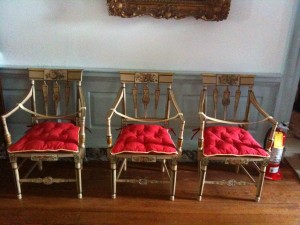Hampton National Historic Site Vist
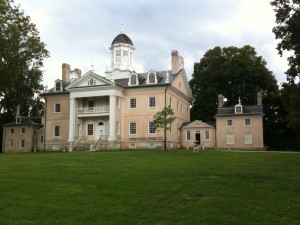 How many times have you driven by a place of interest and never noticed it? I can’t tell you how many times I have driven by the sign for the Hampton National Historic Site on the Baltimore beltway.
How many times have you driven by a place of interest and never noticed it? I can’t tell you how many times I have driven by the sign for the Hampton National Historic Site on the Baltimore beltway.
So a few weeks ago on the way home from a trip to Gettysburg, I finally noticed the sign.
“What is the Hampton National Historic Site?” I asked. Heather shrugged and said she remembered going there on a field trip once when she was in elementary school. So as soon as I got home, off to Google I went and discovered that Hampton is an early American private residence. In fact when the construction was finished in 1790, it was the largest private residence in the country. So the next day, off to the mansion we headed.
The Park Service offers 45 minute tours every hour on the hour from 10-4 and you get a great look at the main house. You can tour the outbuildings and the grounds at your leisure. The Hampton property started as a gift from Lord Baltimore to his cousin Henry Darnall in 1695 and for the better part of the century nothing happened on the property. In 1745 Colonel Charles Ridgely bought 1500 acres on the property and over the next few years expanded his holdings to 11,000 acres. Charles Ridgely Jr built the Ridgely Ironworks on the property and became a major military supplier for the patriot cause. The Revolutionary War made the Ridgelys quite wealthy and at the end of the war in 1783 Ridgely Jr begins construction of the mansion. It will eventually equal 24,000 square feet of living space with extant slave quarters, multiple barns, kitchens, and lavish gardens. The Ridgley family was the height of early American opulence and in 1815, when Charles Carnan Ridgely is elected Governor of Maryland, the property is over 25,00 acres. As Governor, many elaborate parties and state events were held in the mansion and Mrs. Ridgely began her version of “keeping up with the Joneses” but her Joneses were the Madisons in Washington. Every time First Lady Dolly Madison brought a new piece of furniture or modern convenience into the house, the Ridgely’s countered.
This behavior really began the downfall of the family fortune for with the onset of the Civil War and eventual abolishment of slavery, the upkeep costs for the property sky rocketed and practically bankrupt the family. The sad news is the many treasures were sold off to keep up appearances and many a curator mourns the loss of paintings and furniture that were not preserved. Eventually the house and what was left of the property (1,000 acres) ends up with John Ridgely (ironically no family relation) and John and his line live in the mansion until 1979 when the Park Service took over administration of the mansion and 60 accompanying acres of land.
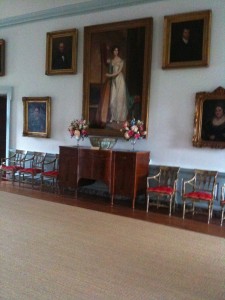 From a woodworker and furniture enthusiast’s perspective there is much to see within these walls. The statement made just in the entry hall is breath-taking. Elaborate architectural moldings with the Ridgely family crest of the stag carved at the apex of every door cannot help but to impress.
From a woodworker and furniture enthusiast’s perspective there is much to see within these walls. The statement made just in the entry hall is breath-taking. Elaborate architectural moldings with the Ridgely family crest of the stag carved at the apex of every door cannot help but to impress.
Of particular note was the massive sideboard front and center of the hall. I found it interesting as the deep case and resulting shortened legs creates such a presence that you tend to feel like you are looking at a Chippendale piece. Of course the clean neoclassical lines and inlay tell a different story. I think what we are seeing here is a transitional piece from the late Federal period into more of an Empire styling.
The exciting thing is most of the furniture in the house was made locally in Baltimore. During the Federal and Empire periods, Baltimore was a hub of fine furniture and many of the inlay and banding patterns you see can be attributed to just a few shops near the harbor.
Flanking the sideboard and spread throughout the hall and throughout the rest of the house for that matter are these painted Baltimore chairs. This is a style that Dolly Madison particularly liked so of course the Ridgely’s had to have lots of them. Each chair is hand painted and features a different image depicted on the crest rail. I have always been intrigued with this spindly design and so far have never been able to sit in one to try it out since usually like in the picture they are roped off. The Baltimore Museum of Art has an entire gallery dedicated to these chairs with painted images of scenes around Baltimore in the early 1800s.
The Park Service has the house set up to embrace multiple time periods so each room has its own character. The interesting point is that the upper floors (lighting is kept low for authenticity so I don’t have any usable pictures, sorry) feature architectural stylings from the late Rococo period rather than the more modern Neo-Classical look of the lower floors. I discovered that this is because the finish carpenters of the day start with the upper floors and work their way down. Since the house took so long to build, the styles had changed by the time they got to the first floor.
Probably my favorite room in the house is a small parlor and office right off the entrance hall.
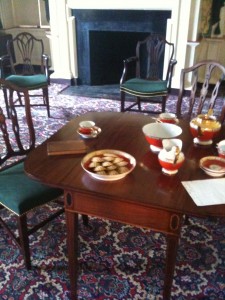 This room is Baltimore Federal through and through with lovely Hepplewhite designs snatched straight from the pages of his design book. Pictured here you see a nice breakfast table, more commonly known as a Pembrooke Table. The rest of the room features several demilune pier tables and a very nice fall front desk.
This room is Baltimore Federal through and through with lovely Hepplewhite designs snatched straight from the pages of his design book. Pictured here you see a nice breakfast table, more commonly known as a Pembrooke Table. The rest of the room features several demilune pier tables and a very nice fall front desk.
Again, the pieces were built locally by artisans like Levin Tarr, and all of the inlay can be traced back to a specific shop located off Light Street in downtown Baltimore.
Unfortunately, my guide wasn’t as impressed by this room as I was so I didn’t get to spend much time here and was quickly moved along to other rooms. My time here however was enough to be inspired and give me a few ideas for the Federal card table I have on the drawing board in my shop now.
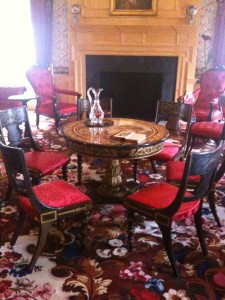 I’ll be honest when I say that I am not really a fan of Empire furniture. It feels clunky to me and the lines don’t flow. It is ironic that a dictator as tiny as Napoleon should spawn a decorative style with such large and massive pieces that would only make him look even shorter.
I’ll be honest when I say that I am not really a fan of Empire furniture. It feels clunky to me and the lines don’t flow. It is ironic that a dictator as tiny as Napoleon should spawn a decorative style with such large and massive pieces that would only make him look even shorter.
Methinks there might have been some overcompensation going on somewhere…
The remainder of the first floor is decorated in Empire and Victorian styles. I don’t mind the Victorian, but it does seem over done compared to the more modern minimalism we seem to be in now so it takes some getting used to. This sitting room does exemplify Victorian stylings and continues the obscene tendency to spend spend spend. The table in the center is the most valuable piece at close to 1 million dollars and is based upon a design by Duncan Phyfe.
Several of these other rooms also featured gas chandeliers and very large mirrors. All a sign of great wealth as they were expensive to manufacture with newly patented techniques. More and more you can understand why the Ridgely’s just ran out of money. It is a shame because so much more could have been preserved through time had it not been sold to the highest bidder.
Regardless, Hampton is a great trip and well worth the time. The grounds can take hours to cover so pick a nice sunny day and have fun. Of course in keeping with this opulence theme, make sure you check out the ice house on the front lawn to see where they kept the blocks of ice harvested on the property from ponds. Nothing speaks high class like serving your 17th and 18th century guests ice cream in the middle of a hot and humid Baltimore July!


